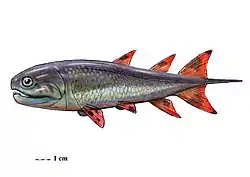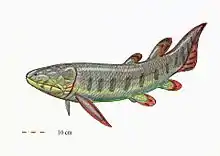Neoceratodontidae
Neoceratodontidae is a family of lungfish containing the extant Australian lungfish and several extinct genera. It and Lepidosirenidae represent the only lungfish families still extant.
| Neoceratodontidae | |
|---|---|
.jpg.webp) | |
| Australian lungfish (Neoceratodus forsteni) | |
| Scientific classification | |
| Kingdom: | Animalia |
| Phylum: | Chordata |
| Order: | Dipnoi |
| Suborder: | Ceratodontoidei |
| Family: | Neoceratodontidae Miles, 1977 |
| Genera | |
| |
Fossils from this family are first known from Triassic-aged sediments in Kyrgyzstan, but phylogenetic evidence indicates that it first originated near the end of the Carboniferous period. Despite their name, they are in fact basal to the related genus Ceratodus (and thus diverged before Ceratodus did), rather than vice versa.[1][2]
References
- "Fossilworks: Neoceratodontidae". fossilworks.org. Retrieved 2020-10-19.
- Kemp, Anne; Cavin, Lionel; Guinot, Guillaume (2017-04-01). "Evolutionary history of lungfishes with a new phylogeny of post-Devonian genera". Palaeogeography, Palaeoclimatology, Palaeoecology. 471: 209–219. doi:10.1016/j.palaeo.2016.12.051. ISSN 0031-0182.
This article is issued from Wikipedia. The text is licensed under Creative Commons - Attribution - Sharealike. Additional terms may apply for the media files.

.jpg.webp)


